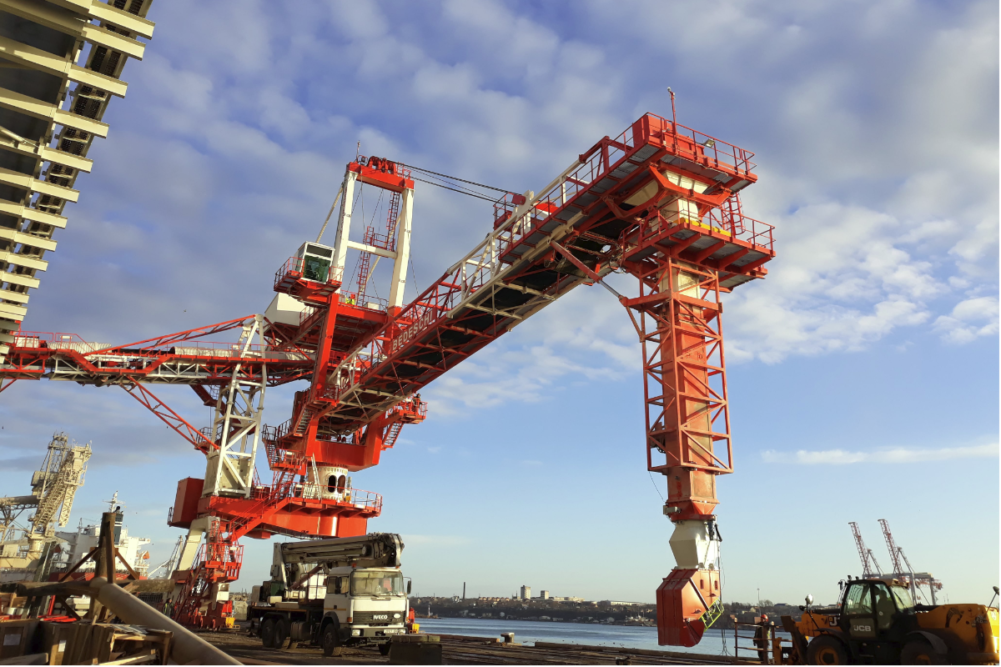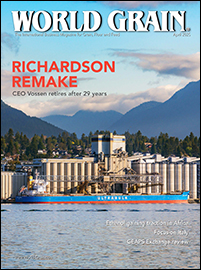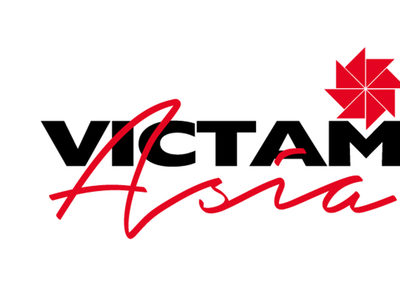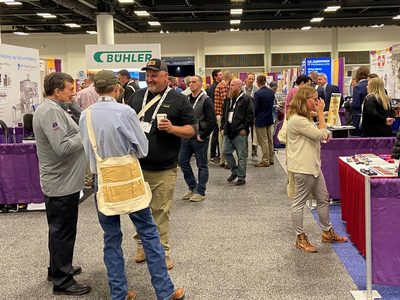As one of the largest and most strategic ports in the southern part of Japan, Konan Futo wanted to find the most efficient unloaders to replace existing equipment that was nearing the end of its life.
It wanted high-efficiency unloading with low energy consumption and low-speed conveying to protect the quality of the main products it handles — wheat, maize, soybeans, rapeseed and raw sugar. The project was just one of the latest by World Grain advertisers who manufacture ship loading/unloading equipment.
The terminal in Kobe, Japan, can store 120,000 tonnes of grain and was originally built in 1969. In addition to storage and loading/unloading systems, the facility includes a soybean sorting plant with a capacity of 150 tpd and a temperature-controlled warehouse with a capacity of 1,800 tonnes for constant temperature and 700 tonnes for room temperature. It can handle vessels up to 80,000 DWT.
After an evaluation phase, Konan Futo selected Bühler’s Portalink ship unloader as the solution that best fit its needs, said Felix Hutter, senior technology manager at Bühler.
“Konan Futo wanted to have a state-of-the-art mechanical ship unloader,” he said. “Bühler has been appointed the preferred partner for this CAPEX project.”
Konan Futo receives raw materials from across the world, including Australia, Canada, the United States and Thailand. Its main focus is supplying the Japanese market, including main customers such as Nippon Flour Mills, Feed One, Mitsui Sugar and J-Oil Mills.
The company needed an unloader that could efficiently handle the variety of grains and sugar. Beyond equipment, it was also essential to find a partner capable of offering project management and customer service throughout the whole process.
“The in-depth assessment process in respect of potential suppliers prior to any sales decision is unique and in line with Japanese business culture,” said Masakatsu Ohkawa, sales manager for Bühler Yokohama. “Bühler has been able to convince the customer of the best-in-class product and services in every aspect.”
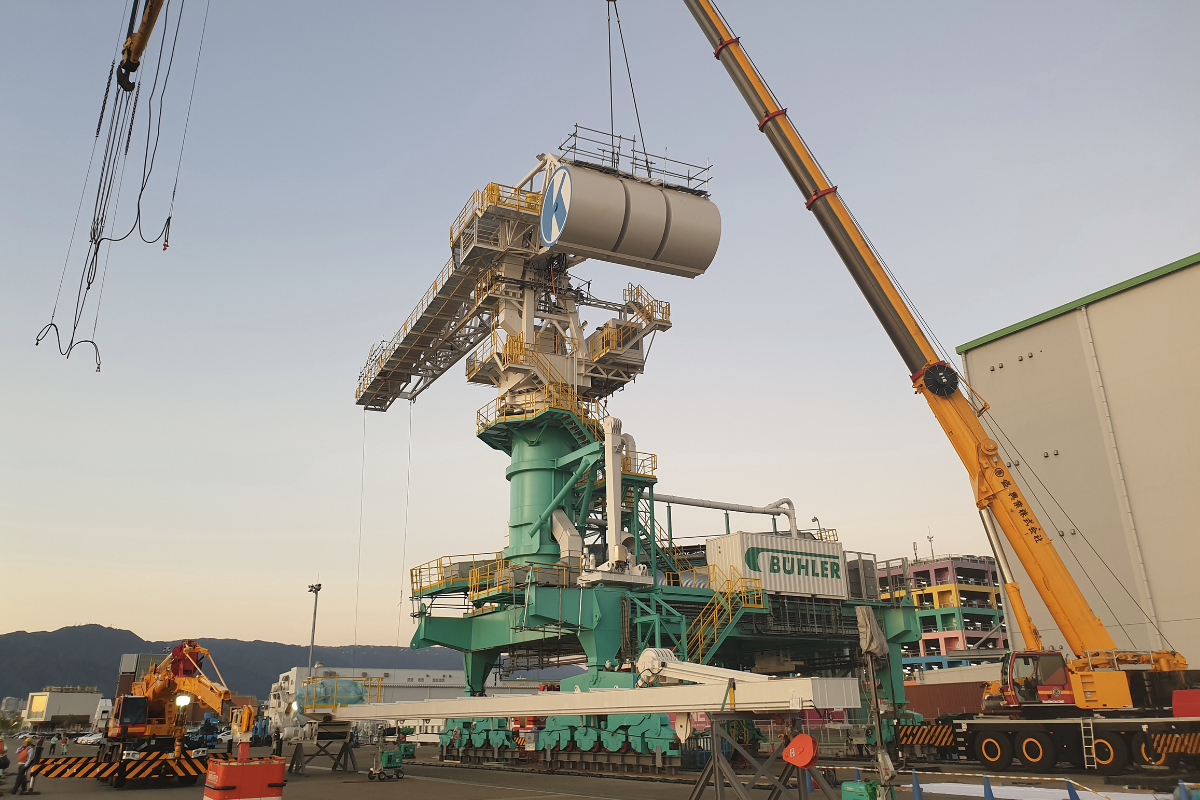
The Portalink supplied by Bühler has a loading/unloading capacity of 1,100 tph and travels on rails. The low-speed conveying lessens wear and tear, thereby reducing product damage significantly. A limited amount of product comes into contact with the conveyor elements, which reduces abrasion.
The new equipment offers outstanding chain conveyor technology and low energy consumption of 0.38 kWh/t.
Since the ship unloader is able to move along the jetty, ship hatches can be reached without any restrictions. Due to the traveling, slewing, luffing, and the kick-in/out movements of the Portalink, optimal hatch coverage is achieved. This results in highly efficient unloading and the shortest unloading time.
The marine leg is key to the system’s overall efficiency and the heart of the machine. It is powered by a low-energy hydraulic drive and a vertical chain conveyor unloads product in a totally enclosed compact column. The intake boot at the end of the marine leg sinks into the product in the hold. The automatic sink-in mechanism keeps the intake boot at the correct level in each hatch as it is unloaded.
By balancing out the vertical movements of the ship caused by wave or rising tide, the automatic sink-in improves safety and lowers stress on the steel structure, thereby extending the life of the unloader.
“We selected Bühler’s Portalink because of its efficiency. Running costs are less than a quarter compared against the two unloaders that were removed,” said Yutaka Fukuda, president of Konan Futo grain terminal. “Bühler provided the highest flexibility and close cooperation throughout the entire project that led to success.”
Logistics presented somewhat of a challenge as space was limited around the existing equipment to assemble the Portalink. To solve that issue, the unloader was shipped from China in semi-assembled parts. After the final assembly on a dedicated area near Kobe, the unloader took its final journey to Konan Futo quay by a huge crane.
It was critical that the final installation time was kept as short as possible to minimize the downtime for the ongoing operation. Coordination of all the stakeholders involved was key during the entire executive process and required dynamic engagement from all parties, Bühler said.
The project was the largest ship unloader Bühler has ever sold in Japan, including the 15-foot jib crane and barge loading boom. The lifting and lowering of the boom and the swiveling motions are powered by hydraulics. Built-in proportional control valves ensure gentle and continuous variable movements. The control system is equipped with PLC elements, and a display shows the operating conditions, error messages and the preventive maintenance program.
Such a significant CAPEX project has drawn a lot of attention. Several Konan Futo customers, as well as other port operators, have visited the installed and commissioned Portalink.
Brazil keeps grain moving

Brazil, a world leader in food production, makes significant use of barges to transport large volumes of grain and agri-bulk produced in the south of the country to northern areas. From the north, these products are unloaded and reloaded for export.
Business at Brazilian ports is booming, and the in-port grain handling systems have had to make advances to keep up. Bruks Siwertell has four high-capacity grain unloaders operating in the country, with each running for about 3,500 hours per year. Across the sites, the Siwertell systems handle millions of tonnes of grain per year.
Operators include Unitapajós (formerly Bunge Brazil) and TGPM (formerly ADM de Portos Pará), in the Port of Barcarena; Cargill Agricola, in Santarém; and Amaggi (formerly Hermasa Navegação da Amazônia) in Itacoatiara.
With the exception of Amaggi, all operate Siwertell ST 790-M ship unloaders with continuous rated grain handling capacities of up to 1,500 tph. Amaggi has a ST 790-F barge unloader and ship loader configuration and a rated capacity of 1,500 tph.
The operators have different equipment configurations that have been specifically tailored to suit their locations and operations. For example, the Cargill facility in Santarém had to take into consideration a tidal range of eight meters, so a floating jetty was needed.
“A lightweight unloader was therefore required to minimize the size of the pontoon and it also had to be small enough to fit inside a canopy designed to protect the cargo operations from the elements,” said Patrik Henryson, sales manager, Bruks Siwertell.
For TGPM, a barge-mounted unloader was needed. It has a small physical footprint and weighs only 254 tonnes. The Amaggi project included a Siwertell barge unloader and ship loader mounted on a catamaran-type pontoon. The unloader is rail-mounted and operates along the length of the pontoon, which plays an important role in a floating grain transhipment terminal installed at Itacoatiara on the Amazon River.
The unloaders run throughout the whole year, so a planned maintenance stop once a year is necessary to ensure continuous operation. The service period varies but averages two to three weeks and typically involves the replacement of wear parts, mostly conveyor screws and casings. During this time, a Siwertell equipment surveyor is always present and a barge docks with all wear parts and the necessary machinery to carry out the service work.
“The remoteness of some of these operations means that these customers often carry a large stock of critical spare parts as well,” said Örjan Westerberg, service contract engineer, Bruks Siwertell. “This prudent approach is intended to minimize the risk of unplanned downtime.”
The systems have minimal environmental impact, which is important since they operate in some of the world’s most scrutinized environments such as the Amazon River. They are quiet and totally enclosed, which minimizes any dust creation.
Kernel completes work on Ukraine terminal
Kernel LLC, a leading Ukraine producer and exporter of sunflower oil and major supplier of agricultural products from the Black Sea region, recently completed a grain terminal in the port of Chornomorsk, near Odessa, Ukraine. It has an annual throughput capacity of 4 million tonnes. Kernel is the largest grain exporter from Ukraine with 12% of the country’s total exports in 2019.
Bedeschi, based in Padova, Italy, started work with the company in 2018 on two ship loaders. The terminal includes two lines, each with a traveling ship loader mounted on rails and equipped with a tripper conveyor to elevate the material in the loader boom. Loading capacity for each line is equal to 2,200 tph and can load Panamax size ships. The boom already has been configured for Cape size vessels.
The self-propelled tripper is fed by a dock conveyor, which extends for 200 meters and is positioned parallel to the parked vessel. To prevent dust emissions due to the wind, the dock conveyor includes a particular rubber belt covering running along the whole profile of the conveyor, including the tripper. The two loaders feature a KiKo type loading boom with a spoon-type dust suppressor.
After a single hold of a ship is filled, the loader is moved to the next operating zone, traveling at a rate of approximately 40 meters per minute.
Kernel exports its products to more than 80 countries around the world.
Senalia Group eliminates dust
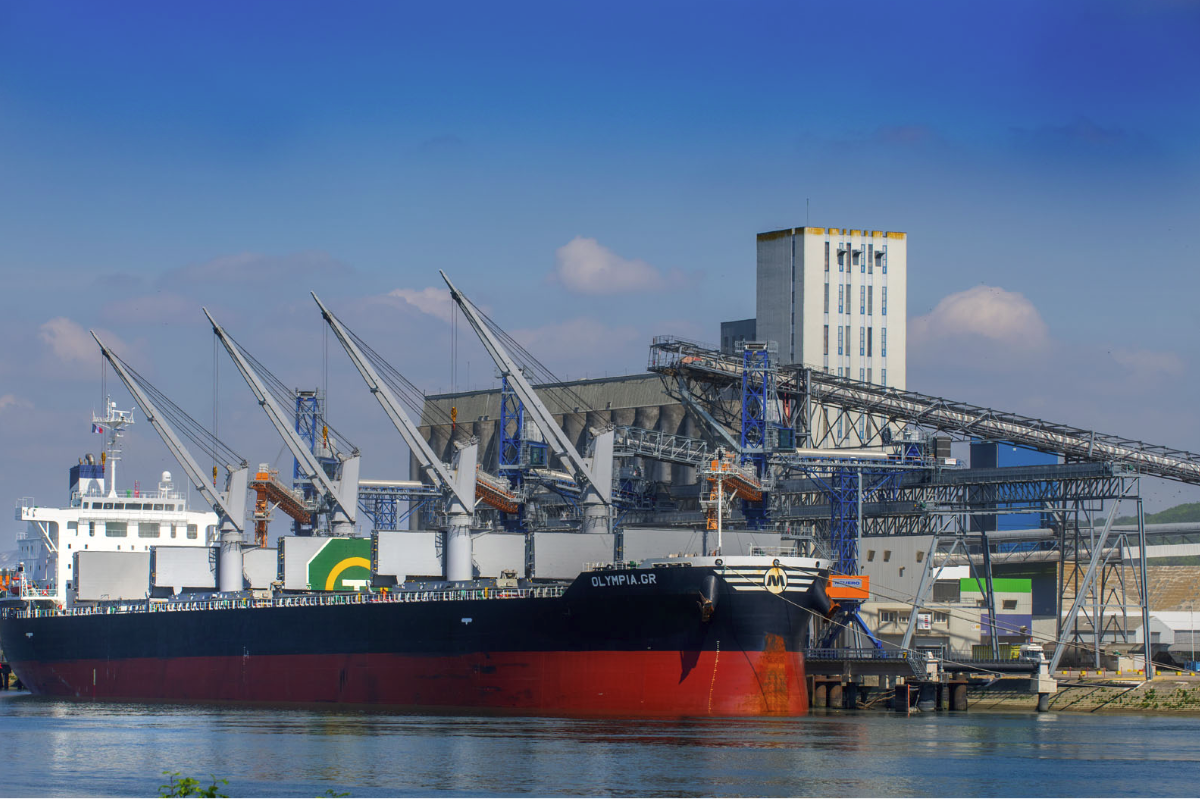
Senalia Group is committed to ensuring its handling operations include innovative solutions that are better for the environment, including its Grand-Couronne, France, location.
Updates at the loading facility completed in February 2019 allow it to now load Panamax-type boats. The loading rate is 3,000 tph without dust emissions and without the boats having to do any ditching operations. The deepening of the base at 12 meters gives ships with a deep draft the ability to stay afloat, even at low tide.
Neuero, based in Melle, Germany, delivered three ship loaders model SL 1000 KIKO DSH to Senalia. The loaders were assembled in Rostock, Germany, and delivered together on a special ship. The new loaders were part of Senalia’s goal to eliminate dust in the port area.
Manufacturers find solutions to COVID-19 restrictions
To deal with the coronavirus (COVID-19) pandemic and resulting control measures, ship loading and unloading equipment manufacturers are finding new ways to keep sales and deliveries moving ahead.
“Being able to keep delivering our products in this environment, with as little disruption as possible, is the main challenge,” said Lodovico Bernardi, sales director, Asia Pacific, for Bedeschi.
Travel restrictions are changing the way the company approaches business, he said. Remote conferencing can only partially solve the problem.
“We immediately introduced a smart-working model for all the employees to maintain efficiency and kept the workshop continuously operative to guarantee support to our customers despite the pandemic,” Bernardi said. “We are positively looking forward to the next months, which will clarify the real impact of the virus on long-term investments.”
COVID-19 makes it difficult to work with equipment that needs local assembly and fine-tuning on site, said Neuero’s Tomas Kisslinger. But the company already has experience working remotely to complete one ship loader in Brazil without sending one person from its headquarters in Germany. A M300 multiport unloader was assembled and started from a distance at Bendasi Port in Libya.
“These are good lessons for the future because nobody knows how long this situation will stay,” Kisslinger said.
Because food is a needed commodity, business is not declining. In fact, Bedeschi is seeing an increase in orders for grain and oilseed bulk handling equipment, Bernardi said.
“The main issues are connected to environment regulations and sustainability of the handling system,” he said. “The demand for new, state-of-the-art equipment is steady but we also see a lot of projects involving more or less radical refurbishment of existing equipment/facilities.”
Some of the most active areas right now are North America, Europe and Ukraine.
Customers are continuing to ask for equipment that reduces dust emissions, has low power consumption and overall efficiency. Bernardi said Bedeschi’s philosophy is to provide a dedicated solution rather than a standardized, less flexible machine.
Thanks to Bedeschi’s experience beyond grain and oilseed bulk handling, it has been able to adapt devices and solutions to different materials.
“Application of our chain elevator unloading technology to a wider range of product and the engineering and construction of a mobile on tires loading/preprocessing machine are the most interesting results of this philosophy,” he said.
Environmental agencies throughout the world have different approaches on how to reduce dust emissions. This lack of a measurable definition makes it difficult to compare one system to another, Kisslinger said. One approach is to define mass flow at loading, reducing the speed in a way that also reduces the dust emissions.
“We supplied the first SL1500 KIKO DSH 1,500-tph ship loader to Bunge in Paranagua and hope that could serve as reference,” he said.
